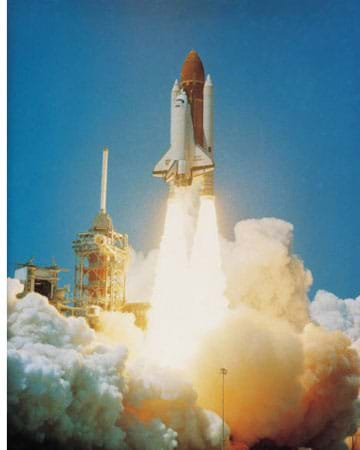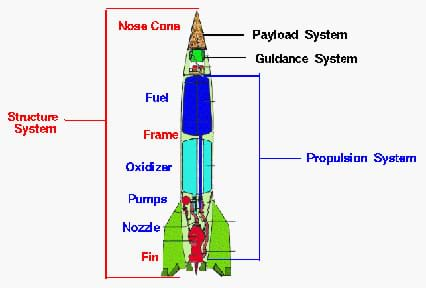Basic Rocket Science and Rocket Components
Rockets are essentially a massive sustained explosion in which the hot gases from the combustion process are directed to create thrust. Of course, it is a very carefully controlled and directed explosion — no small engineering feat! Engineers must design fuel tanks and nozzles that are just the right size, shape and thickness to withstand the pressure of the explosion and accelerate the fuel away. Engineers also design materials and components that can handle the heat and vibrations generated. If their design is too heavy, the rocket may be strong but will not fly; if it is too light, the rocket structure may be too weak and explode.
Rockets move according to the natural behavior described in Newton's third law of motion: for every action there is an equal and opposite reaction. This means that a rocket moves forward by pushing hot gas backwards. The hot gas moving backward is the action, while the rocket moving forward is the equal and opposite reaction. How much power the rocket provides is called "thrust." To create thrust, volatile fuel is placed in a combustion chamber and ignited. When the fuel is ignited, it creates super-heated gas that expands, creating incredible pressure in the combustion chamber. A small opening in the combustion chamber lets the high pressure gasses escape, and a nozzle directs the gas into the desired direction. This is why we see fire and smoke coming from a rocket as it lifts off.
Other common rocket elements include fins, fuel tanks and nose cones. The fins are small wings that keep a rocket moving straight ahead. The great amount of energy required to leave the Earth's surface comes from fuel stored in huge fuel tanks. The nose cone on the tip of the rocket helps the rocket slice through the air. Without the nose cone, it would be much harder for the rocket to move though the atmosphere on the way to space.

On a typical spacecraft, we might also see heat shields, antennae, parachutes, computers, scientific instruments, solar panels and thrusters. The heat shield protects the spacecraft from the heat of re-entry, while parachutes are often employed to ensure a safe landing. Antennae are important for communicating with the ground and sending scientific data. Computers monitor the spacecraft and help the astronauts operate the craft and perform experiments. Thrusters are small rockets that maneuver the spacecraft while it is in space. Solar panels help provide the craft with power; they turn the Sun's rays into electrical power.
The US space shuttle is designed to transport people and cargo to and from orbit around Earth. The main space shuttle components are two solid rocket boosters (contains solid fuel used to push the shuttle into the air), an external tank (holds liquid fuel) and the orbiter (includes a crew cabin for up to seven people; a cargo bay for supplies and equipment, and three engines). A great amount of the space shuttle is devoted to providing fuel. After liftoff, when the solid rocket fuel is gone, the boosters fall back down to Earth. Next, when empty, the external tank comes off. Then, the orbiter reaches space; it is able to return to Earth and land like an airplane. Everything except the external fuel tank is used for another shuttle flight.
Engineers are responsible for all these rocket, spacecraft and shuttle elements. Without them, space travel would not be possible. It is when all these carefully-designed elements work together that we have a successful space mission.
Vocabulary/Definitions
| A process in which one type of substance is chemically converted to another substance involving an exchange of energy. | |
| A person who applies his/her understanding of science and math to creating things for the benefit of humanity and our world. | |
gas:
| Tiny particles with enough energy to remain isolated and free floating (as opposed to liquids and solids in which particles group together). |
| For every action there is an equal and opposite reaction. (This is why rockets work!) | |
| The exertion of force upon a surface by an object, fluid, gas (etc.), in contact with it. Force per area. Measured in units of pounds per square inch (psi) or newtons per square meter (N/m^2) or pascals (Pa). Pressure results from collisions of gas molecules with a surface | |
| A vehicle that moves by ejecting fuel. | |
| The forward-directed force on a rocket in reaction to the ejection of fuel. From: https://www.teachengineering.org/view_lesson.php?url=collection/cub_/lessons/cub_solar/cub_solar_lesson01.xml |


No comments:
Post a Comment